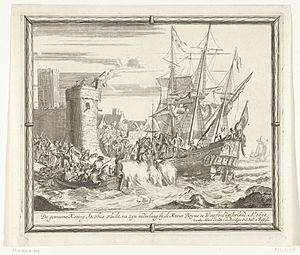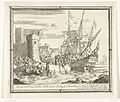Capture of Waterford facts for kids
Quick facts for kids Capture of Waterford |
|||||||
|---|---|---|---|---|---|---|---|
| Part of Williamite War | |||||||
 |
|||||||
|
|||||||
| Belligerents | |||||||
| Commanders and leaders | |||||||
The Capture of Waterford happened in July 1690. It was a key event during the Williamite War in Ireland. A group of soldiers led by Percy Kirke took control of the town of Waterford. The town was held by Jacobite soldiers.
The Jacobites were supporters of King James II. The Williamites supported William of Orange. After Waterford, the Duncannon Fort was also captured. This fort was across Waterford Harbour. Its commander was Michael Burke. Both groups of Jacobite soldiers were allowed to leave safely. They marched to Mallow, which was still held by Jacobites.
Contents
Why Waterford Was Important
After William of Orange won the Battle of Boyne, the Jacobite army left Dublin. They moved west towards Limerick. However, some Jacobite strongholds remained. William's forces then targeted these places.
Waterford was a very important city. It was a major port for trade. People thought it was the second biggest settlement in Ireland. It was one of the last big Jacobite strongholds in Leinster. The city of Wexford had been given up without a fight. Waterford also had many Protestant families. This might have influenced William's plans for the town.
William's Demand for Surrender
William's main army was marching towards Limerick from Dublin. On July 21, William sent a message to Waterford's governor. The governor was John Barret. William demanded that Barret surrender the town.
Barret's answer was not what William wanted. So, King William sent four groups of soldiers and cannons. These forces were led by Percy Kirke. They were ordered to march on Waterford.
Waterford Falls to Williamite Forces
The Jacobites had prepared to defend Waterford. They even destroyed buildings outside the city walls. This was to stop attackers from hiding there. But when Kirke's soldiers arrived, Barret became worried.
He quickly started talking about giving up the town. He wanted his 1,400 men to be able to leave safely. They would rejoin the main Jacobite army in the west. Kirke agreed to this. On July 25, Kirke officially took control of Waterford.
Capturing Duncannon Fort
After taking Waterford, Kirke focused on Duncannon Fort. This fort was very strong. It was located across the bay in County Wexford. Michael Burke, the fort's commander, asked for time. He wanted to send a messenger to Limerick for instructions.
Kirke refused this delay. He began to get his siege equipment ready. Burke first said he would fight. But then a Royal Navy fleet arrived in Waterford Bay. This fleet was led by Cloudesley Shovell. Burke changed his mind and surrendered. His men were allowed to march to Jacobite territory. They were not taken as prisoners.
Some Catholic people in the area took advantage of William's offer. He had offered a pardon to Jacobite supporters. Others left with the departing Jacobite troops.
After the Capture
Later, William tried to capture Limerick but failed. After this, he sailed for England from Waterford Harbour. Some Jacobites thought about trying to take Waterford back. But this was not possible. Waterford stayed in Williamite hands. It remained so until the end of the war. The war ended with the Treaty of Limerick.
Images for kids


